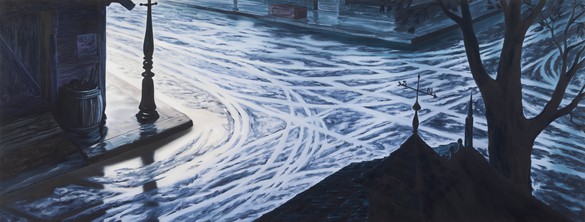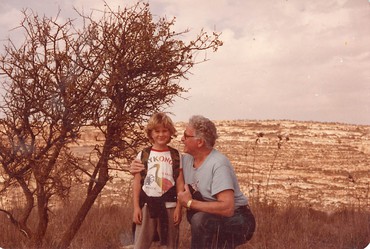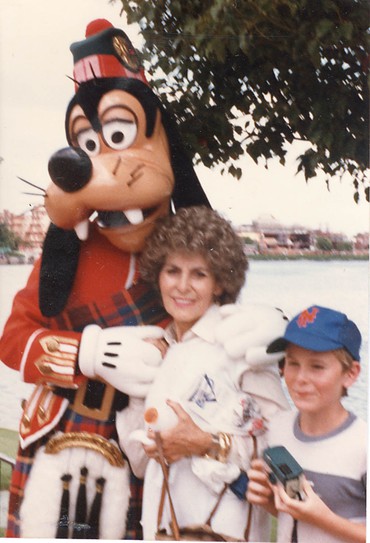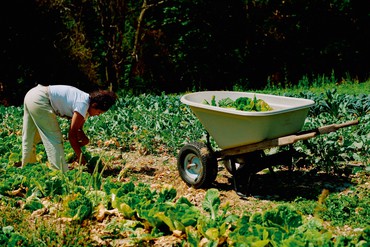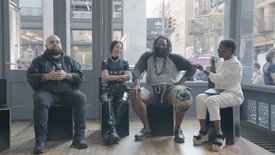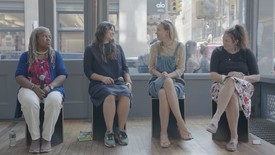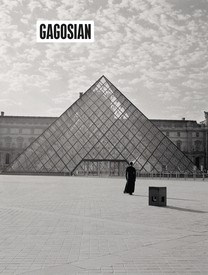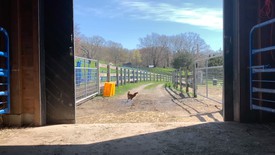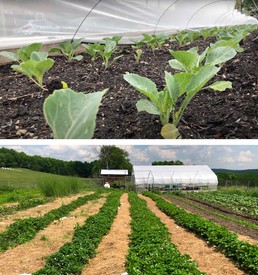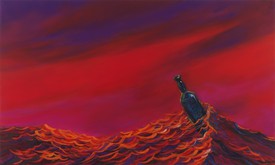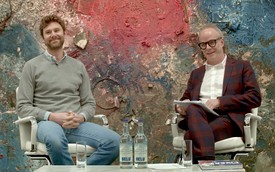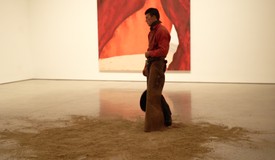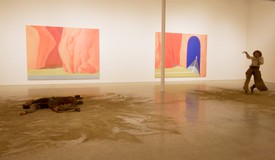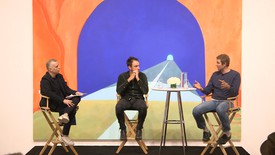
In works ranging from painting and sculpture to installation and performance, Dan Colen plays with familiar materials and cultural symbols to interrogate the relationship between meaning and object. He is the founder of Sky High Farm, a nonprofit committed to improving access to fresh, nutritious food for New Yorkers living in underserved communities.
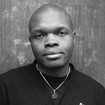
K.O. Nnamdie is a curator, writer, art advisor, and artist based in New York City. He is the director at anonymous gallery and runs Restaurant Projects, a curatorial project and research-driven art-advisory service founded in 2018 and based on Nnamdie’s interest in the intersection between hospitality and the arts. Photo: Thomas Polcaster
K.O. NnamdieHi, Dan. First and foremost, how are you?
Dan ColenGood, man, good. How’re you doing?
KONThings are going well.
DCWe’ve never done a Zoom before, we’re more exclusively real-life friends.
KONYeah, we’re IRL individuals. But you know, we’re very versatile [laughter]. Where are you?
DCI’m at home in the city, with Lexie and our new baby, Days.
KONI’m glad you mentioned “home,” as that’s what I wanted to begin our conversation with. What does the idea of home mean to you?
DCSo many things. In the context of the Lover, Lover, Lover show, I’m using the concept of home as an apparatus to explore the divide I often feel between where I’ve come from and where I’m going. Tension is inherent, but I’m interested in attempts to reconcile the divide and identify moments of peace. The ideas of “home” and “mother” comingle in my mind, and came to be synonymous as the body of work unfolded. In seeking balance between horizon and nostalgia, origin and destination eventually overlapped, became redundant and looping. Pairing these two reflective postures became my focus and drew me deeper into the contradictions implicit within these concepts: “home,” typically presented as a static place, a source of comfort and care, and “destination,” which conjures ideas of the unknown, the aspirational, the new, and the progressive. But in actuality, these distinctions are far from consistent, home and destination (mother and lover), both are complicated and full of ambiguity.
KONAfter our initial conversation over lunch, you graciously invited me to your show at Gagosian in Chelsea. I was struck by a particular painting, Mother (Intersection) [2021–22]. Can you tell me a little about it?
DCI conceived of the Mother paintings when I was away from my home-away-from-NYC in 2009. It was during a turbulent and transformative moment when I was struggling to change certain fundamental aspects of my life. My experiences then inspired this body of work and this ongoing reflection on the fraught nature of home. Dash [Snow’s] death was a big part of what I was responding to—my understanding of his upbringing played a role in how these ideas initially formed within me, as did my blossoming relationship with his daughter, Secret, and her mother, Jade. But my interests eventually turned inward and broadened, moving away from ideas around physical houses and specific family members. I turned my attention to ideas of “homeland” and became more focused on political and historical implications. I explored this line of thinking through my relationship with two nations. One was Israel, a place my family moved to when I was five for a short time: an incredibly complicated place, a nation founded with the aspiration of protecting a vulnerable and dwindling population, a people who had been dispossessed of their homes and families and traditions. That nation then, by nature of its own founding, created a precarious situation where many of the same tragedies were inflicted on another people. These tensions between security and violence are the crux of my interests.
The other nation is America—another place I associate with home, and equally fraught. My Disney series, which I began in 2003, was a way for me to contemplate America and my place in it. I’m interested in these promised lands, and in the balance they find between care and support, oppression and control. Disney worked for me as a mechanism to try and represent these incongruities I see in the world and in me.
KONThe show felt like a culmination of a lot of things you’ve been working toward, and in an elegant manner it felt like a fork in the road, just like Mother (Intersection): the freedom and movement, on the one hand, and the decision-making, anxiety, and isolation on the other. I understand that you’re taking a pause on the Disney series, so what’s going on in the studio nowadays? Where has that intersection been taking you?
DCOver the course of my career my work has taken on many dimensions, but underlying much of it has been a persistent investigation into relationships among material, process, and narrative. These last few years have allowed a renewed focus on oil paint, and with this focus I’ve been able to explore the craft and chemistry of a material with limitless applications and resonances. Finding the right balance between technique and intuition has been vital to my momentum. I’m distrustful of the pursuit of mastery, but given my priorities it’s kind of inevitable. . . . I strive to relegate it to the periphery. No matter how much I can manipulate or control the material, the science is so nuanced, and the alchemy so potent, the material supersedes all my convictions. Early on in my practice, I used several nontraditional painting materials to accentuate these relationships, but my interests have circled back to oil paint. For me to make progress on that facet of my work, I need to be in my studio, and in an utterly natural way the pandemic supported that evolution. This show was actually my first big oil-painting show since 2003.
As I mentioned, the Disney series began in 2003, with the Candle paintings. The newest works in the show, the Woodworker paintings, are based on the same scene from the Pinocchio story as the Candle Paintings, taking on Geppetto’s worktable as their subject. It felt natural to conclude this body of work where I began it. Although I’m still actively working on it, there’s an end in sight. Bringing the Disney paintings to resolution is a process negotiated between my mind and the material. The subject dictates the process and the process in turn dictates new subjects, or old subjects. I already sense it will soon become important for me to explore new themes that will allow the material exploration to break through.
KONI felt this resolved moment approaching when I saw the show, and I was really happy for you. It felt like a full circle—you were coming back to where you’d started and then slightly pivoting to the left. I know that right now you’re working on another practice, which is the farm. So I wanted to hear more about how Sky High Farm is doing and what the current undertakings are with it.
DCI think two things have allowed me to give the oil paintings the focus I hadn’t been able to for the last ten years. The pandemic, as I mentioned, is one of those things; the other is the farm, which has allowed my art practice to develop in so many different ways. My role at Sky High has evolved over the last decade: I’ve come to a place where I have a lot of clarity on my place within the organization and on the organization’s place within my practice. When I founded the farm, it was intuitive, mirroring the way I create in my more traditional studio projects. At a certain level that’s still true, but the farm now functions within the structure of a 501(c)(3). Acclimating my process within that context has been challenging but also deeply fulfilling and ultimately inspiring. I’ve continually pursued new modes of creation. These overlapping explorations into an expansive range of materials, processes, and themes drove my creative practice but also inevitably made it hard for me to make progress on my paintings. I feel like the farm is a new source for a similar energy and feedback I had been accustomed to experiencing while pursuing a variety of projects at once. There’s a clear relationship developing between the farm and the paintings that has allowed me to maintain productivity and progress with them both.
KONI just want to say that with the farm, you’ve beautifully expanded your audience far beyond the art bubble, and you’ve been laying down these bricks in regard to making your mark and leaving your legacy. What does that mean for you in this moment now that you’re a father, and you just wrapped that beautiful show with your dad’s work in it? It feels like you’re getting ready to do something really big.
DCSky High’s impact is growing. Its work is both broad and focused. There’s the agricultural aspects, there’s the food-access program, there’s a fellowship, there’s educational programming—mostly focused on engaging young people but with offerings for adults as well—and there’s a grants program, which is quickly becoming of growing importance to our mission. In 2022 we distributed $250,000 to farmers and activists who have been overlooked, oppressed, or marginalized by the agricultural system and who focus on promoting food sovereignty within their communities. Then there’s also a brand, Sky High Farm Goods, created to support the work of the farm. We strongly feel that our ability to support pathways toward food sovereignty depends on our efforts being distributed throughout all these layers within the food system.
At the end of the day, it is what it is, just like a painting is what it is, no matter what I say about it. I think people should come to it on their own, free of any relationship I have with it. For me it’s most fulfilling and generative to understand it within my art practice, but it has the flexibility to be different things for different people.
Sky High is first and foremost a public-health initiative, an urgent one. Two years ago I made the decision to set it up as a public nonprofit, a 501(c)(3). This moment allowed for an interesting convergence; in a sense I agreed to give it away. I would no longer have control over it—I agreed to work with a board of directors, and to be responsible to the donors. But at that same moment, I became more ready to embrace the farm as an artwork and as a fluid part of my practice as an artist. And there’s that funny tension there, right? The idea that an artist needs to maintain an almost diabolical control over the creation process was ingrained in me throughout my formative years. The board, the staff, and our partners and collaborators challenge those notions and have allowed my practice to prioritize different forces and allegiances.
In the past two years, we’ve grown our capacity and physical footprint exponentially. This growth has allowed us to spend more time articulating exactly how the farm operates as both an agricultural organization and an arts organization. I think that’s important to communicate clearly to our audience and our partners. Sky High offers so many different people a wide range of ways in—as an audience, as participants, as beneficiaries, as stakeholders, donors, collaborators, etc. Engaging with the individuals at all those various touch points is probably the most fulfilling part of this work.
KonThe Judd Foundation symposium seems particularly relevant to this. I’d love it if you could tell me more about how that event fits into Sky High’s broader work.
DCThe Judd symposium offered us an opportunity to share our work with our New York City audience and to bring our partners and friends into a specific space, one that allowed the ideas to connect with history and the work of another artist. It gave us a moment to reflect on our work, organize our ideas, and see them in relation to each other. We believe these events can be clear calls to action, not just intellectual exercises. For me, it was an opportunity to further contextualize Sky High within my art practice. Bringing people together in site-specific settings to exchange, create, and collaborate is a strategy I’ve deployed over the years, starting with early works like the Nest [2007], a performance and installation I created with Dash, and recurring in other sculptures and performances like Livin’ and Dyin’ [2012–13] and A Real Bronx Cheer [2012], and more recently in works I’ve been conceiving with dancers—the most recent of which, of course, you included in your group show Vegyn [2021]. That was an awesome show, and series of shows, you’ve been curating.
I’m interested in relationships that can form, grow, develop, and unravel on a stage. Sky High’s first fundraising event is another example: we had performances by some of New York’s best dancers, from American Ballet Theatre, Gibney Dance, and Alvin Ailey, followed by a panel of bipoc farmers sharing their work and discussing the challenges they face, and an offering from Stonewall Protests, a Black trans liberation group. Bringing these unlikely cohorts together was illuminating. Our board is composed with a similar sensibility, bringing together people from arts, fashion, agriculture, public health, and justice initiatives. I’m interested in choruses and collectives and think of Sky High as operating in similar ways to how artists’ collectives historically have.
KONThe community engagement that the farm has generated has been incredible. It’s important and impactful for artists to show that we can and do need to give a damn about something that’s not ourselves.
DCAbsolutely! I’m by no means the first or only person doing something like this, it even seems to be becoming part of a zeitgeist, but there are important historical touch points. I’ve benefited from having studied, witnessed, and dialogued with other artists pursuing comparable paths. Linda Goode Bryant has offered me infinite insight and inspiration. Artists such as Theaster Gates, Rick Lowe, and many others have helped clear the path. It’s really hard to hold on to intention and purpose as an artist as you move up and through the art industry, it’s such a convoluted world. The farm has allowed me to see, accept, aspire toward, and eventually participate in all these “other” art worlds that exist and thrive outside of the art industry, which is most often thought to be at the center of artistic innovation.
KONThere are truly other art worlds out there! But the more I think about it, your work has always been about community, and it’s been amazing for me to realize through the farm that this type of working is no different. It’s maybe just on a grander scale.
DCWell, there’s a very nice full circle here. In the years since I founded the farm I’ve had so many insecure moments about the organization and the work it does, but especially about my place in it, and also its place in my art practice. That kind of doubt and questioning is inevitable and healthy and that’s what it means to consider whether something is an artwork at all, and whether it has potency or power. My friends have played such important roles in helping me confront these questions and insecurities. Home comes to mind again and in this context can be considered through an alternate lens: in my early career, or actually before my career really began, I felt like I was part of an art world, a world that my friends and I created together—Ryan [McGinley] and Dash and Kunle [Martins], irak, all of those folks. Our friends—our community, as you put it—weren’t limited to just the immediate crew; Nate [Lowman], Agathe [Snow], Raina [Hamner], Banks [Violette], and Terence [Koh] all helped shape my experience and my aspirations as an artist. As a career develops, you’re thrust into different environments; dialogues and exchanges unfold in new ways, and an artist’s relationship to fundamental aspects of their world changes. What an audience looks and acts like takes on new qualities. In a sense, for me at least, it was inevitable to seek out something that satiated me in the same way, or in as intimate a way, as those initial relationships did and still do.
Dan Colen: Lover, Lover, Lover, Gagosian, West 21st Street, New York, September 7–October 22, 2022
Artwork © Dan Colen
